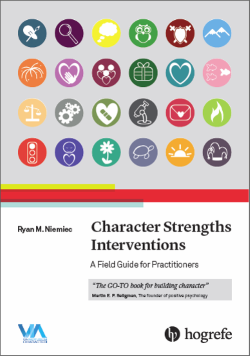OK, Now What?
This is a common question you might be asking after you have identified the strengths of your clients, students or employees. If you are using a free VIA Professional Site, you can get access to their VIA Survey results immediately after they complete the assessment. But then, it’s up to you to help them navigate how these strengths can improve their happiness, boost their relationships, and contribute to greater success at school or work. This three-step process provides you with a framework to help you dive deeper into their results and see the benefits that a strengths-perspective provides.
Aware-Explore-Apply Strengths Model
1. AWARE
The first step of any change process is awareness. This crucial step involves getting the language of strengths down. After your client, student or employee completes the VIA Survey, use their results to build common language around strengths together. For example, “perseverance is a high strength for you, this means you work hard to get things done.” During this step, they are discovering the answer to: “What are my strengths?” and beginning to answer the question: “What strength was I just using?”
2. EXLORE
This is the phase in which you help them connect the strength labels in a deeper way to their past and current experiences. It begins to shed some light on who they really are and what really makes them tick. This step involves solitary reflection, pondering, and journaling, as well as interpersonal discussion and co-exploration. Ask them questions about a strength you observe in them or about any of the 24 strengths in their VIA Survey results.
- How do the results fit for you? What is your gut reaction?
- What surprises you most about the results?
- Do the top five resonate for you as signature strengths? In other words, do you feel these are the core of who you are and that the strengths give you energy when you practice them?
- When have you used that (curiosity, fairness) strength in the past?
- When you think about a time when you were functioning at your best, which strengths did you use?
- When you think of a time when you were anxious, depressed, or highly stressed, which strengths did you use to move forward?
- Consider your past or current mentors (or role models or paragons). What strengths did they embody? How did they express them?
3. APPLY
This step involves helping them discover ways to use their strengths in more their daily life. This is the action phase. This is where they move from reflecting and thinking to actually doing. You might start with the question, “Which strength are you interested in applying in your daily life?”
Another angle is to directly point out themes that have emerged in the exploration questions. For example, you might point out that hope and perseverance seem to keep popping up in discussions, that they seem to use self-regulation well at work but not at home, or the theme that they frequently overuse their curiosity and under-use their creativity.
Some people will immediately know what to do with their VIA Survey results and begin using their strengths in new ways and building up strengths they’d forgotten they had. But, many others will benefit from the creation of a concrete “action plan” that is integrated into their goals. This is something you can explore together. For instance, if they would like to become a more strengths-oriented person, one part of their action plan may be that they consciously identify strengths in their environment and in the interactions, they experience and observe. Encourage them to notice their spouse showing kindness, the grocery clerk displaying prudence, the movie character displaying fairness, and their boss displaying judgment/open-mindedness.
Repetition and moving forward
Repeating these three steps is encouraged and highly recommended… and in any order. In fact, they function best when they are repeated frequently. Repetition underscores practice and practice is the key to developing any of the character strengths.
It would be beneficial to keep these three steps in mind during all of your interactions with your clients, students and employees. After they have taken the VIA Survey, jump into some exploration questions. If you have been processing a few of these questions already, then it might be time to create an action plan. Remembering these 3 words will help you move from a “stuck” point of not knowing what to do or say next and help you keep your momentum going!


